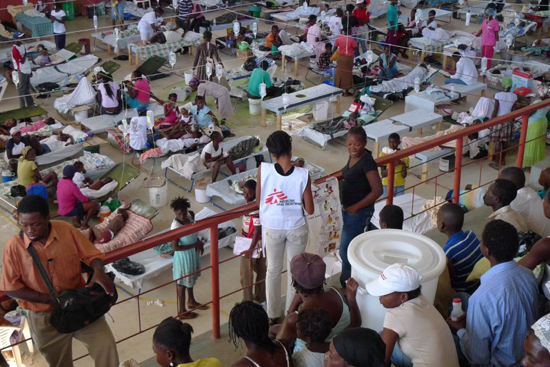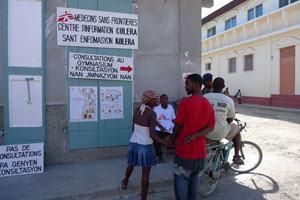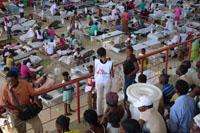Communications is a crucial component of MSF's cholera response in Cap Haïtien and elsewhere.

Haiti 2010/© Aurelie Lachant/MSF
The Gynasium CTC in Cap Haitien
On November 5, soon after mobilizing in response to the cholera outbreak in Haiti, Doctors Without Borders/Médecins Sans Frontières (MSF) sent an emergency team to Cap Haïtien. Situated on the northern coast, the country's second-largest city is home to 325,000 residents. From the outset, MSF teams made it a priority to reach out to the population through a communications campaign that explained the nature and the treatment of cholera, along with MSF’s work.
Demystifying the Disease, Combating Stigmatization
The initial images of the cholera outbreak were traumatic. The first cases that appeared in Cap Haïtien were isolated in the city's Gymnasium, but the medical personnel on hand in the city lacked the resources and supplies required to respond adequately. The prevailing lack of knowledge about the disease, which moves swiftly if not treated in time, left Haitians at all levels of society vulnerable to fears, rumors, and speculation. Fearing stigmatization in their communities, patients were afraid to tell anyone that they were ill. Many died at home or reached medical facilities too late to be treated.
When the MSF team members arrived, they found approximately 30 patients in the Gymnasium. The mortality rate was very high; to Cap Haïtien residents, the sports center was a place where people went to die. "One of the key problems was explaining the illness to the authorities and the population who wanted to close the Gymnasium," says MSF's emergency coordinator, Helmi Mekaoui. "People were terrified by what they saw. There were dead bodies in the streets."
After negotiating with the authorities and the community, MSF established a cholera treatment center (CTC) inside the Gymnasium and hired people to manage the crowd and to maintain the hygiene of the facility. The emergency team focused on communications as well, setting up an Information, Education, and Communications (IEC) team designed to explain and demystify the illness so that people would accept a treatment center in their midst. "While the medical teams worked ceaselessly to reduce mortality and save as many lives as possible, the health educators went into the communities and identified patients, the people with them, and passersby to show them that the center had been cleaned up and that patients were being cared for there."
In the next four week, MSF treated more than 4,000 patients at the CTC in the Gymnasium and lowered the fatality rate from approximately 14 percent to approximately 1.4 percent.
Easy to Treat and Prevent If People Know How
The IEC team had to start with the basics, because the Haitian population, which hadn’t seen cholera in decades, knew very little about the illness. "Patients were arriving at the CTC, but they didn't know what they had," explains Hugues Juillerat, MSF's IEC program manager in Cap Haïtien. "As soon as we got there, our most important job was to get the message on treatment and prevention out to as many people as possible."

Haiti 2010/© Aurelie Lachant/MSF
Part of MSF's public information campaign in the city.
Health and information workers were hired and trained to talk to patients and their family members, neighbors, and friends about what cholera is, how it's transmitted, and how it can be prevented. Initially, there were six people in the IEC. Two weeks later, there were 40 of them making their way through the CTC's hallways and crisscrossing the streets of Cap Haïtien to educate the population.
"People don't understand that such a fatal, contagious illness can be treated so easily, or that it can be prevented by methods that are seen as so rudimentary—by washing hands, drinking potable water and providing sanitation," Mekaoui says. The health educators explained to patients that treatment would center on rehydration, and that they would be given an oral serum, a saline rehydration solution. "Patients think that if you don't give them pills, they're not being treated," says Lukinson Jean Francois, the supervisor of the CTC health workers. "You have to explain that rehydration gets rid of the cholera vibrio [bacteria]. You also have to remind their family and friends constantly about hygiene rules, including washing hands with chlorinated water after being in contact with the patient and not sharing food with them, because in the beginning, many of those people were getting sick, too."
Local media also plays a role. Radio spots explaining prevention measures are broadcast in Creole on the major stations in Cap Haïtien and surrounding areas. MSF health workers and medical staff participate in broadcasts that emphasize prevention measures and answer questions about treatment and transmission. It all goes back to the original goals of demystifying the illness, lessening the stigmatization, and encouraging people who are ill to get to a CTC as quickly as possible.
Changing Perceptions
In early November, there were a host of patients in the recovery room who were no longer ill but were afraid to return home for fear of infecting others. People had gradually come to understand the CTC and the treatment provided there. "When they saw mortality rates dropping, they began to realize that the Gymnasium was no longer a place where people went to die, but that most people had recovered by the time they left," Juillerat explains.
There's still work to do, of course, especially in more isolated villages. Health awareness personnel join MSF's mobile outreach teams when they travel to clinics in rural areas, looking to provide supplies and training and also to recruit local health workers who will then be able to educate their communities. On December 1, the IEC team opened an information center in central Cap Haïtien where three health workers talk to passersby about prevention methods. "In the first three days, the information center registered more than 300 visitors each day," says the Emergency Coordinator. "That's a good indicator of the need to educate and create awareness in the communities."
Easing Access, Continuing to Communicate
The communications effort will continue, as will MSF’s attempts to give more people access to the care they need. The organization has opened new CTCs on the outskirts of Cap Haïtien, in Quartier Morin, Vertière, and Fort St. Michel, and is supporting health centers in the more distant rural communities of Dondon, Bahon, Grande Rivière du Nord, St. Raphael, Limbé, and Plaisance.
Oral rehydration points (ORP) have been set up as well. "This allows patients who are just developing symptoms of the illness to be treated and prevents those who live too far from a treatment center from reaching a stage of advanced dehydration," explains Narcisse Wega, medical manager in Plaisance.
Ideally, the IEC efforts in Cap Haïtien can be replicated as MSF extends its work further into Haiti’s Northern Department. Although it is difficult to measure the precise impact of the awareness campaign, Juillerat notes that "the questions people ask now show that they have a better understanding of the illness and how it's treated than they did a few weeks ago. They're not afraid to go to the Gymnasium any more."




